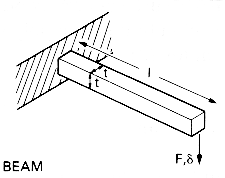| |
|
As an
example of how the minimum weight criteria were obtained, consider a common
structural shape, a cantilever beam supported at one end and loaded by some force,
F, at the other end. In general, there will be some design parameters
that must be met, for example the length, L, section, t x t, of the beam, and
the load, F, it must stand without deflecting more that d. These quantities are related to the Young's modulus of
the material by: d = 4FL3/Et4.
The mass, M, of the beam depends on its density, r, and volume, Lt2 : M = rLt2.
Evaluating
t2 from the mass equation and putting this value
in the deflection equation gives: M2 = (4FL2/d)(r2/E). The material's
properties are only in the "red" term, and the "blue" term
contains only design constraints. To get the lowest mass system that will
meet the restraints requires selecting one with the lowest value of (r2/E) or the maximum value of (E/r2).
|
|
|
|
|
|
|
|
|
|
|
|
| |
Similar
procedures are used to select a material on the basis of resistance to plastic
deformation. For this same shape the yield stress, sy, is related to the applied force, F, by: F = syt3/6L. Using the expression for the mass
to get rid of t in this equation gives: M = (6FL)2/3(r/sy2/3)., where
the material properties are again in the red term. This shows that to obtain
the lowest mass system that will remain in the elastic range during use we
need to select on the basis of the lowest value of (r/sy2/3), or the maximum
value of (sy/r3/2). This expression also shows the importance of
the material density. |
